Pepo Hernando – El Temps de les Arts
Artículo de Ramon Casalé en @eltempsdelesarts sobre ‘Me multipliqué para sentirme’ de @pepohernando
—
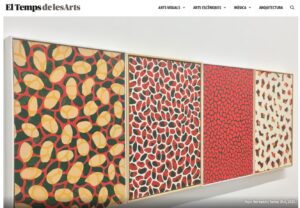
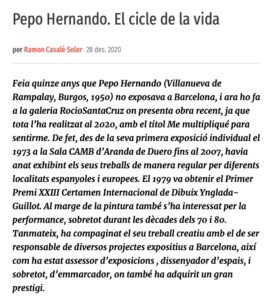
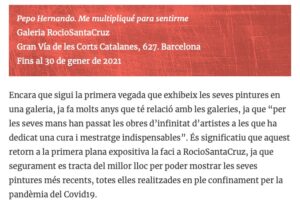
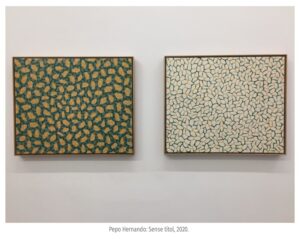
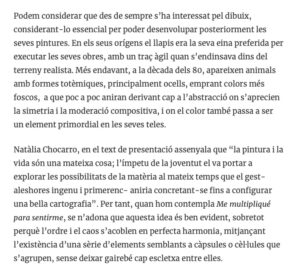
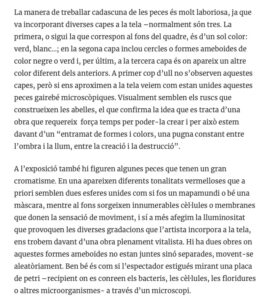
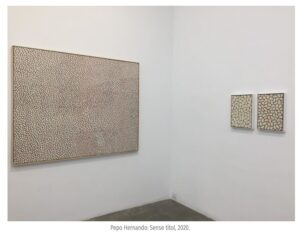
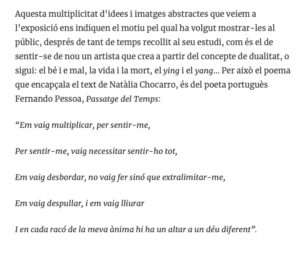








In this fourth issue of Paris Photo online, we present you with the work of Antoni Campañà (Arbúcies, 1906 – Sant Cugat del Vallès, 1989), photographer whose work moves between pictorialism and avant-garde experimentation. Also known as a leading photojournalist, his photographs of the Spanish Civil War remained unknown until 2019. Campañà collected nearly 5,000 photographs of the war and kept them hidden for decades.
RocioSantaCruz is currently working with Campañà’s unpublished oeuvre. Paris Photo 2020 was to host the first international presentation of Campañà’s work We are pleased to share some of his photographs in this online edition.
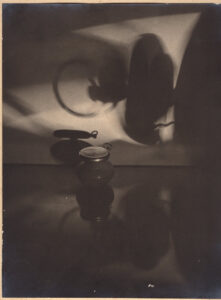
The double gaze of Antoni Campañà
Antoni Campañà was born at the same time as photojournalism, a field in which he made his career as a sports reporter and pioneer of the tourist postcard. Before turning thirty, Campañà had achieved wide national and international recognition for his refined mastery of bromoleum technique. In the years before the Spanish Civil War, he received numerous awards and consolidated his position as an artist. He was a member of Agrupació Fotogràfica de Catalunya and in 1933 he traveled to Munich to train with photographer Willy Zielke. He carried out an important work of experimentation and innovation, thus transcending the pictorialist parameters and becoming an unparalleled benchmark of experimental photography in Spain. From those early 30s, we still have compositions like Tracció de sang (1933), framed within the traditional portrait of farming and tradition.
When the war broke out, Campañà’s political commitment made its way into his work, leading him to compose an extensive photographic documentation of the war. Unlike many of his contemporaries, Campañà’s visual testimony remained hidden for decades. Thirty years after his death, his family found the images stored in red boxes, which come to light in La Caja Roja (2019), an investigation of Plàcid Garcia-Planas, the historian Arnau Gonzàlez i Vilaltaand the photographer David Ramos, published in Catalan and Spanish by Comanegra and by Éditions du Seuil in French.
Untitled, 1928-1930
Reflecting on this unknown period, it becomes clear that the Spanish Civil War opened a symbolic trench that Campañà was forced to cross, not only as a citizen, but also as an artist. As he moved from one side to the other, his career changed radically. The early Campañà, concerned with meticulous preparation and aesthetic harmony, gave way to a Campañà shaken by the frantic rhythms of battle, death and reality. His camera turned him into a witness to the horrors of truth, and only when shooting with the Rolliflex, which he reserved for portraits, did he allow himself to explore a more avant-garde style.
As a reflection of the ravages of war, the artist’s decision can be read as a symbolic attempt to bury an all too painful past. The Franco dictatorship foreclosed the mere possibility of creating spaces of social reparation where losses, both political and personal, could be avowed. Thus, Campañà’s silence regarding this period of his work is understood as a direct effect of the sheer lack of collective languages of mourning, an effect of the impossibility of addressing trauma. Campañà’s work speaks about the trajectory of an artist, about how his gaze adapts to the volatility of life, but it also speaks about the importance of collective memory. Thanks to his red boxes, today we can add new pieces to our narrative and find new words to name our grief.
In this eighth issue of Paris Photo online, we present you the work of Miguel Rio Branco (Las Palmas, 1946), one of Brazil’s contemporary artists with widest international recognition.
His multidisciplinar career crosses over the fields of photography, painting, video and installation. Rio Branco’s highly poetical compositions are characterised by an eloquent and overwhelming aesthetic, which often relies on his use of chromatic intensity and chiaroscuro techniques.
Rio Branco is currently featured in two important exhibitions in Europe and Latin America. Le Bal, in Paris, gathers his first photographic period in Miguel Rio Branco – Photographies 1968-1992, which will be held from December 16 until March 21 2021. In São Paulo, Instituto Moreira Salles presents Palavras cruzadas, sonhadas, rasgadas, roubadas, usadas, sangradas, an intensive retrospective which, taking the artist’s personal archive as a point of departure, goes over the main themes of his work.
Visceral aesthetics in the aftermath of pictorialism
Rio Branco does not shy away from the body, rather he dives into visceral tones. His photography and cinema bear the influence of his pictorial training, which imbues his style with a particular materiality. Displacement, loss and grief are key themes in Rio Branco’s oeuvre. Pain and sexuality are sublimed in his use of saturation and contrast. All of these elements are conjugated under a prevalent sign of ambivalence, especially in his photographs: opposing courses of action confront each other, caught in a vicious struggle over the ownership of the image. Turned into a sort of visual trench, the image becomes a site of excess, heavy with meaning. Rio Branco does not intend to mirror that which already is, but rather he creates new possibilities of existence, new gazes, new truths.
Es un placer anunciaros que la galería RocioSantaCruz ha recibido dos Premios GAC 2020, a la Mejor Programación en Galería y al Artista por la Mejor Exposición en Galería, para Gonzalo Elvira por su exposición Idilio.
Queremos agradecer a los miembros del jurado su reconocimiento y, de parte del equipo de RocioSantaCruz, dedicárselo a los artistas que integran nuestro proyecto. Su arrojo, excelencia e incansable empeño nos reafirman en nuestro camino y nos recuerdan que el arte es un lugar que habitamos conjuntamente.
En estos momentos tan duros, personal y profesionalmente, y con el sector cultural fuertemente sacudido por los estragos de la crisis sanitaria, recibir estos premios tiene un significado especial que queremos compartir con todos los compañeros y compañeras del gremio de galeristas. A quienes os quedáis trabajando después de bajar la persiana, a quienes no dejáis de buscar nuevas formas de acercar el arte al público, y de abrir puertas a través de la cultura. A todos y todas que vivís con pasión vuestro trabajo, este reconocimiento también es vuestro. Si algo ha quedado claro este año, es que necesitamos andar juntos.